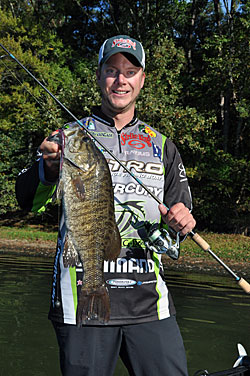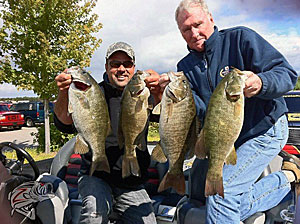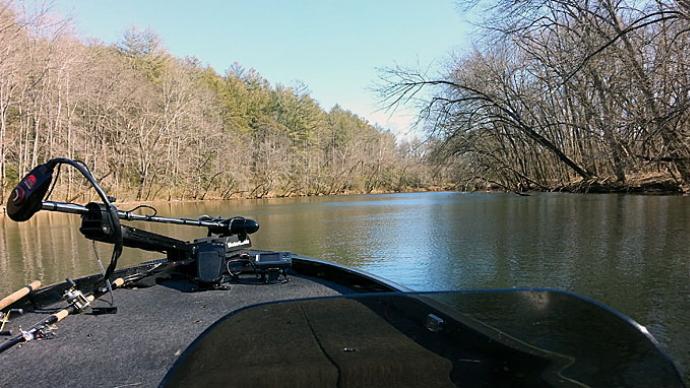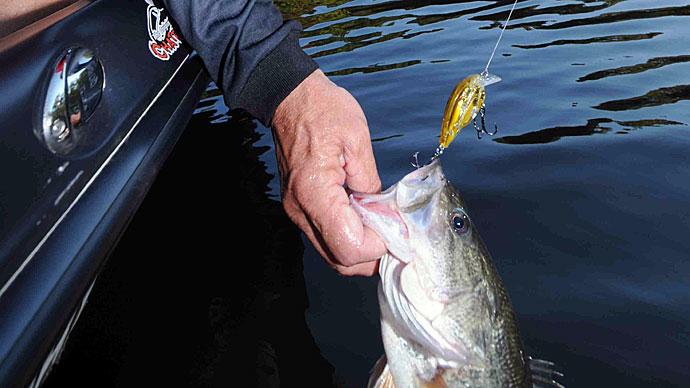
River fishing is the bain of their bass fishing game for many anglers. Despite having the rods, reels, and gear, something about river systems psychologically unnerves the best anglers. Bassmaster Elite angler Jonathon VanDam is well known for his smallmouth bass fishing prowess and another fellow Michigan smallmouth bass guru and host of “Zona’s Awesome Fishing Show,” Mark Zona. They teamed up to share their river fishing logic and help you put the odds in your favor.
Think Shallow
VanDam focuses on small, isolated pieces of structure that are not like the rest. He uses his Humminbird Onyx units to scan up to 150 feet of each side of his boat using side imaging. He prefers the blue background as it best displays hard structure, while using the amber background is best for graphing vegetation. Once he finds a sweet spot, he’ll place his cursor over the top of the structure and punch a waypoint that he’ll further examine using 2D or down-imaging.
Finding spots outside the norm is vital, especially if they are isolated. If you find a rocky edge and a piece appears to have broken off or is more pronounced, your better fish would always relate to the best piece of the structure. Finding key drop-offs can be productive also.
“These edges typically aren’t doing to drop off to 100 feet,” VanDam said. “Some of my best ones go from 55 to 30 feet throughout 40 to 50 yards. To key in on it, you get on that edge, and you’ll find little sections where it makes points or high spots right on the edge. Depending on the fish's mood, they’ll do a bit of everything. They’ll sit on top, down off it, and suspend off it. It all depends how the current is that day.”
VanDam has found that the stronger the current, the shallower those fish will be. They can’t hang in the swift currents of the deeper water for as long as one might think. “There’s enough stuff to slow it down in the shallower water, and once you get out deeper, there isn’t as much,” VanDam reasoned.
Seasonal Tactics
Spring
“You want to throw some search bait, a jerkbait, or swimbait around shallower areas with little to no current. The less current, the better because that’s where those fish will pull up to spawn,” VanDam said. “Sometimes there’ll be a little current, but they’ll get up in those little bays and get behind a rock where their nest is out of the current.”
This is one time of the year when you won’t need a deck full of rods. It would be best to have a dropshot rod and your favorite dropshot baits, preferably brightly colored. The only rod that works for VanDam is the G-Loomis NRX 822S DSR paired with a 3000 series Shimano Sustain spinning reel spooled with 10-pound braid. From there, he’ll run a leader of 8-pound fluorocarbon. On the business side of things, he prefers to dropshot a Strike King Dream Shot worm Texas-rigged on a 1/0 Lazer Trokar TK-180 hook. He prefers the Siren color, an extremely bright chartreuse color, as it makes sight-fishing far too easy.
While some anglers will fish whichever size of Dream Shot is most convenient, VanDam is quite particular. While the Magnum size does cut down on the amount of small fish brought to the boat, he quickly points out that he’s caught far larger fish on smaller bait.
If he wants to cover water, he’ll opt for a Strike King Swim ‘n’ Shiner rigged on a ¼-ounce ball head that he’ll swim back to the boat with a straight retrieve. Blue glimmer, white, and ayu are colors that consistently produce.
Summer
Come summertime, VanDam continues to look for areas that break up the current like minor points, edges, and rock piles. “That’s why broken up rocks are more important than a slab of sheetrock. It will stop that current where the sheetrock won’t,” VanDam reasoned. The presence of bait is reason enough for VanDam to stop and take a closer look.
Figure out how the fish are positioned on the structure is equally important. “Most of the time, fish will position right behind the rock pile or right on the leading edge. I make short drifts and get a good cadence with the lure bouncing along the bottom through the area. I'll make another drift if I catch one or mark one,” VanDam said.
VanDam suggests that anglers work on getting their presentation to tick along the bottom without getting snagged up. Developing a rhythm is critical for anglers trying to learn when to lift their bait over a snag or how to get it dislodged should it get hung up quickly. When fishing a dropshot, a 3/8-ounce weight is plenty to maintain contact in less than 40 feet of water, while a ½-ounce head works best with his Strike King Coffee tube.
When it comes to picking colors for his bait selection, JVD tries to match the hatch. “If you are fishing a pile and there is a bunch of bait suspended around it, shad patterns will work better. If you’re dragging your dropshot through there and feel gobies bite, green pumpkin, and dark melon purple work best,” VanDam explained.
VanDam still looks for smallies to be shallow, even in the summer, especially in the St. Lawrence River, as smallmouth will head shallow to cruise around and feed. He’s found that, interestingly, the smallmouth retreat to deeper water once the sun disappears, and unconventional colors like morning dawn and brown/purple are great options when throwing a Dream Shot.
“It doesn’t make sense because you would think that if it’s sunny, it will push them deeper because the baitfish go deeper because of the light penetration. But, those smallmouths can see so good, they get up shallow roam around and chase bait and eat crawfish, gobies or whatever they can find,” VanDam said.
Fall
Come fall, VanDam will look for smallmouth to set up in pockets as bait typically gets pushed. Under the right situations, fall fishing can be nothing short of extraordinary. Smallmouth will gravitate to essential structures from 2- to 30- feet of water.
Fishing the Great Lakes in the fall can be frustrating at best due to unpredictable and vicious winds that will muddy up the lake and flow into nearby rivers. VanDam advises anglers to adjust to the changing conditions by going shallow, finding the clearest water pockets, and fish with reaction baits.
Tricks of the Trade
VanDam focuses hard on finding the sweet spots in the river and doesn’t lose focus. After all, he found them for a reason. “I’m not going to make a two-mile drift and drag around and hope to catch one here and there. I’m focusing on those key spots, making a couple of hundred-yard drift, and when I find those spots and hit that waypoint, I’m going to catch one,” he said.
He noted most anglers rarely go back to where they caught their fish. When he hooks one, he'll punch a waypoint, especially since he started toying with the Motorguide Xi5. He’ll use the anchor feature to hold him in place as he fights a fish, unhooks it, or wants to hold it in a critical area. “When I hook one, I hit the spot-lock, and it would hold me right there, and I’d fight the fish. If I missed one, I could make a long cast and get it back down to where it was,” he said.
Northern Michigan River Mayhem

Mark Zona films Zona’s Awesome Fishing Show from one end of the country to the other. A few times of the year, get him jacked up about fishing as fall-time in his favorite northern Michigan rivers. Those are big words for a guy who can fish anywhere in waters that many anglers drive by but never consider fishing.
By the end of summer, Zona especially pays attention to the moon. “The end of August and into the beginning of September, when we get a full moon, the bait tends to move toward the rivers out of lakes,” he explained. No doubt, the smallmouth are quick to follow their food source.
“That’s the initial time it is getting ready to start, but that full moon puts them into the rivers out of lakes. I’m not big on watching the temperature, except the spring and the fall, but generally, when water temps dip below 60 degrees, there will be a major push of smallmouth into our river systems. But it only lasts until it gets down to 50, and then they are done with fighting that current,” Zona said.
“The prime water temp is generally mid-50, and then the last blast is the end of September to mid-October. That is the prime time in the North generally. That's when the masses of bait will be there and the bulk of the schools of smallmouth also. You can catch them until the water drips into the 40s, but your numbers drop off. This pattern is every single year.”
There’s something magical about the fall as it breathes life into the ecosystem. “Those river systems become a circle of life comes the fall because I see musky fisherman, walleye fisherman, and a lot of that is dictated by the food coming through there,” Zona explained.
“I think you get emerald, alewife, and a movement of suckers from four inches up to a pound. It’s almost a funnel that life goes through come fall because that life is not there during August!” Zona knows from experience. He has graphed and idled the same rivers during August only to find baron waters. This drives home that those fish in the river during the fall are migratory, and timing and location are the deal.
Since he is fishing shallow river systems, he’s only looking for the deepest pools. If the average depth of a shallow river is 5- to 6- feet, he will look for 8- to 10- foot holes as smallmouth will mass congregate in those spots for two reasons. Primarily, they’ll sag in the bottom of those holes to avoid fighting the current. Also, the fish are looking to ambush whatever bait is coming through there.
Smallmouth tend to group up hard in those holes on a sunny day, and you’ll need to make the same cast repeatedly. “I like it more on the nastiest gnarliest days because they tend to get out of those holes and feed more aggressively,” Zona explained.
Zona’s studied these river systems for enough years to know that smallmouth tend to get on the lips and front edges of those holes under rougher conditions and will be far more aggressive. These rivers run no deeper than 10 feet. Where he might have only caught two fish under sunny and normal conditions, he’s fished the same spot days later to rack up two limits at 25 pounds each once the water got angry. “The fish that come in there are alphas,” Zona said. “These holes might only be a foot or two feet deep, but smallmouth use every small transition.”
He’ll idle a whole river system looking for the deeper holes and will GPS all them only to fish every one after he gets his boat turned around and his game plan straight.
Many of Zona’s best holes have an object in them, whether a stump or some object that flushed down that river and became an obstacle.
Double Fisted
Zona sees no need for a whole bunch of rods and reels. A G-Loomis NRX JWR 873 S paired with a Sustain 3000 or the new Stradic is all he needs to get the job done. His lure choices are simple- a finesse jig or a dropshot rig.
The jig is an easy choice because come fall, those river fish are chewing on crawdads, and according to Zona, the jig is the “weapon of all weapons.” He’ll fish either a ¼ or 3/8-ounce Strike King Tour Grade Finesse Football jig on 10-pound braid with a 10-pound fluorocarbon leader. His jig trailer choice is less than conventional.
“I slice a tube jig body in half and use the bottom end much like you would a chunk. It slicks through the current much nicer than anything bigger,” Zona explained. He’d discovered it almost by mistake nine years ago when he was about to start taping a show on a skinny river and realized he’d left his jig trailers back home. The results were astounding, leaving Zona in disbelief with how well the smallmouth ate the pairing.
Green pumpkin and watermelon jigs with matching tubes for trailers are all you’ll need making for a pretty affordable tackle box!
He’ll bat cleanup using the same mentioned rod and reel paired with 6-pound fluorocarbon to dropshot a green pumpkin 4’ Strike King Ocho Texas-rigged on a Trokar TK 180, the same straight shank finesse hook that VanDam uses.
As current dictates the weight of his dropshot sinker and wind dictates current, the lightest he’ll opt for is 1/8-ounce for those times when a slack wind stalls the current, and 3/8-ounce should increase the wind speed of the current through the hole that he’s fishing. The benefit of the dropshot rig is that he can keep it stationary in current for those times that smallmouth will not chase the football jig tumbling along the bottom with the current.
Making the right cast is critical, and once you catch a fish from a certain angle, don’t bother throwing it anywhere else- you unlocked the code. “I don’t like fishing the usual position downstream- throw up current and let the bait come. I like to keep my boat at 7 o’clock and throw to 1 o’clock, and I like to let the current flush it to my side,” Zona explained.
“For me, it’s a lot more natural where I don’t have to tight-line my bait much. I want the current to be the action of my bait. That’s very hard for me if I’m fishing from down current to up current. What’s stunning is how overly aggressive the bites are in those rivers. Those fish will rip your gear out of your hand!” By watching your line, you’ll be able to tell the instant your presentation has been bit.
Hit them Fast and Hard
With age comes experience, and Zona’s learned that river smallmouth, especially those that live in shallow rivers, get hip to the gig once someone starts putting hooks into their buddies. “Fish become intelligent fast. When I figure out the deeper pools that smallmouth are using, I know that I usually have two to three cracks during the fall before they get weary,” Zona said.
While Zona can go to specific rivers and get 100 fish a day, the quality won’t be there. Yet, if he selectively chooses rivers fed from the Great Lakes, he might only get 10-12 bites, but those fish will be in the 4- to 6-pound range.




